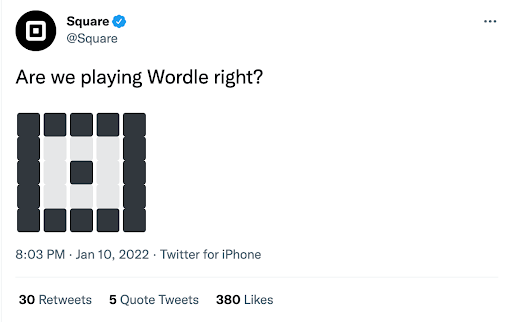Culture-jacking is a common practice among brands; it happens when a company appropriates aspects of entertainment, music, and media for commercial purposes. Most times, these trends are primarily marketing strategies. Companies chase trends to stay relevant among competitors that appeal to younger generations.
Culture-jacking may seem fun and exciting, especially when it comes to the “newest” platforms like TikTok, where every other week, there’s a new trend that can make you go viral. Whether it’s on TikTok, Twitter, or Instagram, going viral is a key objective for many brands; however, it can become counterproductive if the trend doesn’t align with the company’s mission.
The goal is to be on top of the consumer’s mind, but how can brands understand when they fit the trend? When deciding to join a trend, it’s fundamental to take into consideration if the juice is worth the squeeze. Companies must consider if the trend aligns with their values, if the content is appropriate for the platform, and if the effects of that content will give five minutes of fame versus long-term results.
It’s also important to consider which platform to target. Every platform has its unique language, therefore the content you post on TikTok might not be successful on Instagram.
The first thing brands must take into consideration is studying their audience. Understanding your community and what they want will make it easier to decide whether or not a trend is suitable, and consumers will be more likely to support the company.
Timing is crucial
Although there are many platforms where brands can research trends, it’s almost impossible to predict them. Trends evolve rapidly; most of them are unpredictable because they happen from one day to another, and it’s essential to jump on the trend at the right time. That’s why every company that wants to join trends should have someone constantly present on the internet. It’s critical to enter trends in the initial phase to maximise audience engagement and its benefits.
Pick the right trend
It’s not always an easy decision to make, but companies should keep in mind that they don’t need to take on every trend to stay relevant. Just because something it’s funny and popular doesn’t mean that it is suitable for the brand’s audience. Give your personal twist to it so that consumers can perceive a natural link between the brand and the trend. Avoid creating a sales moment, it’s meant to be a moment of interaction and fun.
Don’t try too hard
Consumers can tell when a brand is struggling to fit in. Utilising words like “Cringe,” “Cheugy,” “Pushing P” can have an opposite effect than the one desired and won’t connect with the audience successfully.
Avoid being counterproductive
On the other hand, culture-jacking can be inadequate and unproductive. Let’s think about what Burger King UK did on Twitter for International Women’s day. The brand’s account tweeted: “Women belong in the kitchen.” they tried to quickly make up for the tweet by adding, “if they want to, of course.”
The intent was to point out that only 20% of chefs are women and that the company is on a mission to change the gender ratio in the restaurant industry by empowering female employees. The brand started to get backlash and accusations for utilising sexism as clickbait, the audience was disappointed, and the chain ended up deleting the original tweet and apologising.
The Burger King case shows how much is essential to test the content internally before a “post” button gets clicked. A rapid survey inside the marketing team will be sufficient to see if something is wrong with it or if it might be offensive to somebody. When it comes to essential topics like Women’s International Day, Black History Month, and Pride Month, brands should evaluate their contribution to the public conversation and their actions to approach such thematics.
For example, practices like “rainbow washing,” where brands change their profile picture to a rainbow to appeal to the community, happen every other year, and consumers are not impressed anymore.
What is your brand actually doing to support the community other than appealing to the social media audience?
Recently, authenticity and transparency are changing the social media game for influencers, celebrities, and brands. Authenticity doesn’t only refer to being genuine and trustworthy, but also putting out content that’s relatable and that allows connecting on another level with the audience.
When brands create marketing campaigns based around public holidays, coming up with a new creative concept can be challenging; that’s why jumping on trends and having an opinion on publicly discussed topics has become the new normal.
Just as a consumer can detect when an influencer is not authentic, the same goes for brands. In the long run, creating a community is much more important than going viral for taking part in a trendy competition. By building a solid community and staying true to the core values and brand message, you won’t have to worry about getting in the for you page.
TikTok is still a very new platform; many brands are unfamiliar with the platform and feel intimidated. But in reality, it can be a huge opportunity to connect with a Gen Z audience on another level. For example, If you have been scrolling on TikTok, you might be familiar with the Duolingo account, which the 23-year old Zaria Parvez runs.
Duolingo participates in many trends, whether it’s a meme, a dance, or a filter. The main character of the account is the green owl, the brand’s mascot. The content is very Gen Z friendly and never severe, their tone of voice is sociable and unhinged. As a result, the brand has almost three million followers, and the community adores and supports it. brands can leverage TikTok challenges not only by following trends and trying to keep up with the app but also by creating them from zero. This way, brands can express their personality and values while interacting with the platform.

Let’s take as an example one of the hottest trends on social media right now: Wordle. Wordle became popular recently because it is a straightforward yet genius game. Developed by the software engineer Josh Wardle, the game’s scope is to guess a five-letter word in six chances. People started to share their scores on social media, and brands also jumped on the trend train by sharing memes and their take on it. Wordle is an excellent example of how brands can be on-trend by not taking too many risks. It’s perfect for sharing content and engaging with your users on the latest topics, but don’t try too hard!
Square decides to recreate his logo using the Wordle layout:

And TikTok Philippines chose to participate as well:

In conclusion, brands should think about themselves almost as creators to connect with users; you want to engage with your followers personally by being authentic and genuine. Trends can definitely help but make sure to choose the right ones. Getting on trends just for the heat of the moment can be underproductive and cause a heavy backlash.








